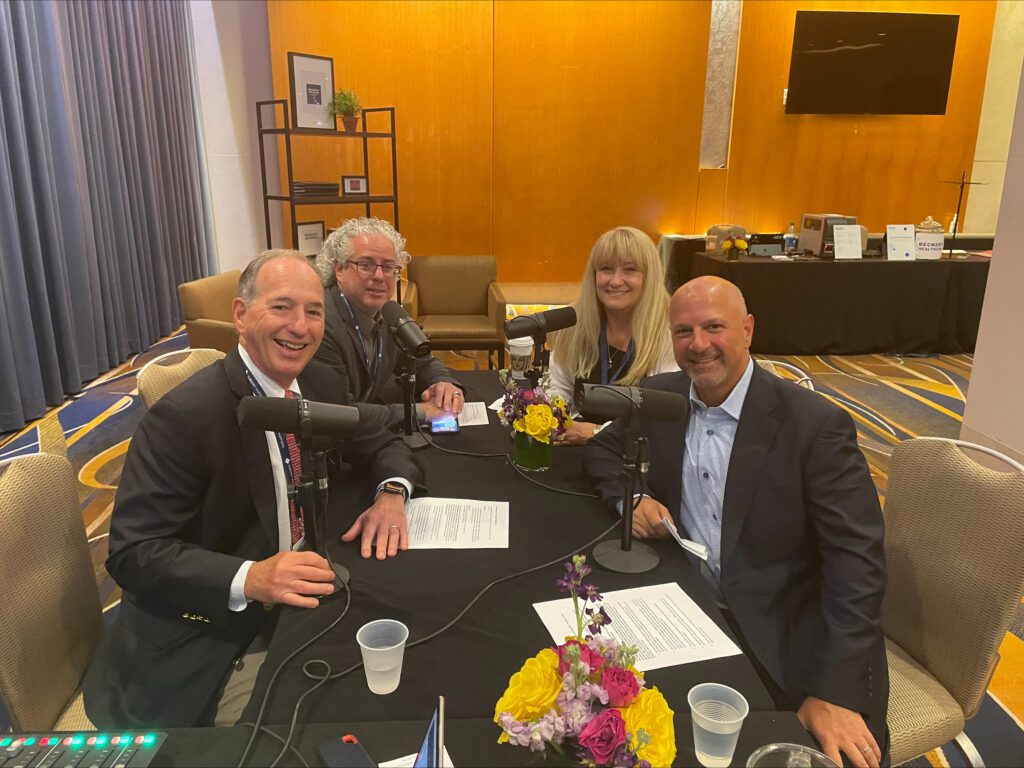Five Orthopedic Trends in Today’s Marketplace
Insights from ASC Experts on What’s Driving Change and Maximizing Results
Discover the latest orthopedic trends shaping the ASC industry in this insightful podcast episode, broadcast live from the 20th Annual Becker’s Healthcare Spine, Orthopedic + Pain Management-Driven ASC Conference.

nimble solutions CEO, Nader Samii, and President, Lisa Rock, guest hosted the Becker’s Healthcare Podcast. They sat down with orthopedic industry experts Dr. Scott Sigman and Dr. Michael Redler to delve into the dynamic landscape of ambulatory surgery centers (ASCs) and the influential role of orthopedics.
Let’s explore the top 5 takeaways from their enlightening discussion.
1. Total Joints and beyond: which orthopedic procedure are migrating to ASCs
As total joint procedures have successfully transitioned from hospital outpatient departments (HOPD) to ASCs, the focus now shifts to spine surgeries. The potential for spinal fusions under local anesthetic presents exciting opportunities. However, cost remains a crucial consideration.
Balancing the expense of procedures and implants with the need for outpatient care is a challenge. The podcast hosts discuss the importance of expanding outpatient capabilities for ACL repairs, shoulder procedures, and other surgeries to promote patient recovery at home.
2. ASC outcomes matter: the rise of employer-funded and self-funded group plans
As more companies shift from offering a commercial payer plan to their own employer-funded or self-funded group plan, ASCs have to navigate the process of establishing new payment bundles and contract negotiations. In terms of surgical procedures, employers seek efficient options that facilitate a swift, complication-free return to work for their employees.
ASCs offering high-quality care at a lower cost have always been an attractive solution, especially since ASCs have lower infection rates than hospitals. While ASCs possess a competitive advantage in terms of outcomes, Dr. Scott Sigman and Dr. Michael Redler recommend tracking your ASC’s results and include advantages when developing bundled packages. Specific examples and data-driven results will showcase your ASC’s value proposition.
3. Therapeutics and technologies: revolutionizing the ASC paradigm
Ultimately, ASCs are looking for more ways to improve patient comfort, episode of care, and the overall patient experience. Pain management takes center stage in terms of therapeutics and technologies for ASCs. Maximizing the patient’s healing potential is paramount, as is finding new ways to leveraging the body’s natural abilities to heal.
Advanced techniques, such as regional blocks, can help facilitate pain relief, but providing long-term pain relief and greater comfort to patients will truly improve the patient experience.
Finding ways to incorporate better technology in medicine, from integrating AI and real-time feedback during surgeries, is the goal in further enhancing patient care and outcomes. The ability to have a comfortable experience overall and a faster recovery time also enables ASCs to take on more cases.
4. Overcoming business challenges: orthopedic implants and reimbursement
Implants are the biggest expense for orthopedic procedures in the ASC setting. Implant reimbursement is posing significant financial challenges for orthopedic ASCs due to several factors from Medicare reimbursement cuts for physicians, anesthesia shortages, and overall decreases in payer reimbursement.
The rising costs of implants, coupled with low reimbursement rates, hinder the financial viability of many procedures in ASCs. Dr. Scott Sigman and Dr. Michael Redler emphasize the need for support in navigating the business side of orthopedics.
5. Harnessing social media for patient engagement
When surgeons see patients as individuals, not just broken parts, they promote better outcomes. Social media can be used as a powerful tool for patient interaction. Sharing patient testimonials and videos about their experiences at your ASC also fosters trust and establishes rapport for potential clients.
Social media can also educate patients on your procedures, recovery times, and the overall impact on their lives so they know what to expect. When patients are better prepared, their recovery and overall well-being improves.
Final thoughts: the changing landscape of orthopedic ASCs
The consolidation of orthopedic groups (and their ASCs) is marking a significant shift in the outpatient industry. Smaller independent practices are giving way to larger groups, facilitating better cost control and operational efficiencies. The increasing involvement of private equity groups adds a new dimension to the orthopedic business landscape as well. However, the podcast panel emphasizes the importance of maintaining surgeon credibility based on results rather than solely relying on a renowned name or scale.
To dive deeper into these intriguing topics, tune in to the full podcast episode.
Are you looking for ways to improve your revenue cycle management? Take the first step towards optimizing your revenue cycle process by requesting a revenue assessment from our team of RCM experts. Request a demo.